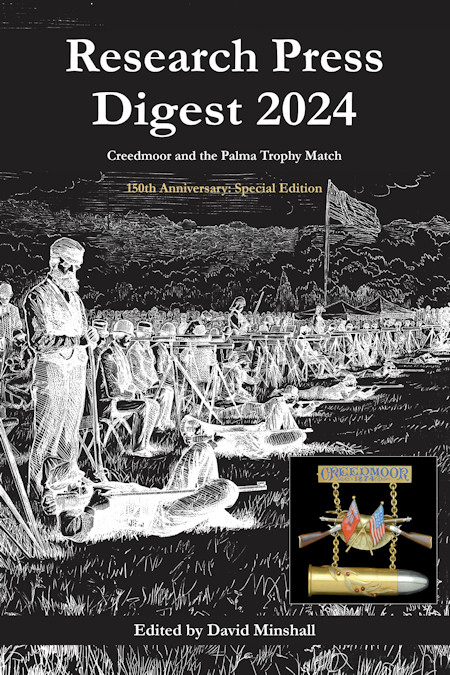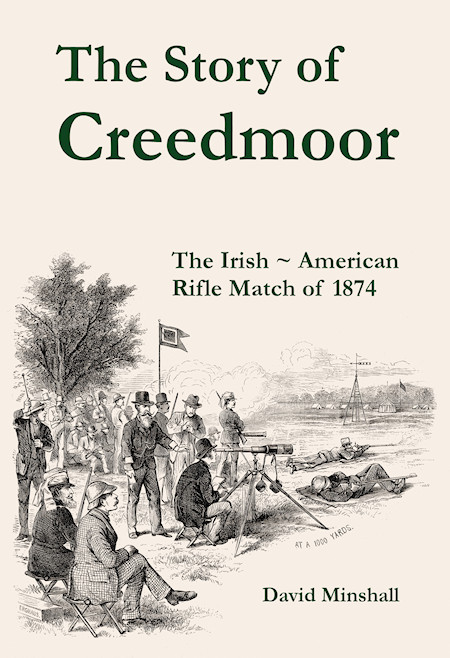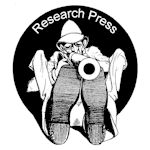In 1892 the ailing National Rifle Association (NRA) of America put its records into storage and, following negotiation with the New Jersey State Rifle Association, transferred its matches from Creedmoor to Sea Girt. By 1900 these matches had grown significantly and the Board of Directors of the NRA met in December that year, the first such meeting since 1892. One of the outcomes of that meeting was plans to resurrect competition for the Centennial or ‘Palma’ Trophy.
During the American’s team practice in August 1901 long range veterans Frank Hyde and S.I. Scott were in attendance. Hyde, then described as a “well preserved gentleman in his fifties, with gray beard and clean cut features,” was present in the capacity of coach. Via Shooting and Fishing he extended an “invitation to all long range shots to be present as they can conveniently arrange it during the present preliminary practice, and to the conclusion of the Sea Girt meeting. If these veterans do not shot, he believed they will find much pleasure in renewing old acquaintances, and no doubt give some valuable suggestions to the younger riflemen who are investigating the intricacies of long range rifle shooting.”
The competition for the Palma Trophy took place at Sea Girt, New Jersey, on 5 September 1901, with shooting at 800, 900 and 1000 yards. Teams of eight representing Canada and the United States of America competed, with Canada winning scoring 1522 against the USA on 1494. On 6 September a special challenge match between teams representing the Ulster Rifle Association of Ireland and the New Jersey State Rifle Association took place, shooting again at 800, 900 and 1000 yards. The Irishmen won, scoring 1620 against the New Jersey men scoring 1558.
These competitions revived memories of the once famous Amateur Rifle Club of New York whose members had made notable victories in the short series of international long range rifle matches in the period 1874-1877. Although never formally dissolved, the club had faded away. Col. Leslie C. Bruce, a member of the USA Team that beat Great Britain in 1877, gathered many of the long range veterans together for a reunion in December 1901 and the event was reported upon in Forest and Stream.
|
The Riflemen’s Reunion Twenty odd years ago the doings of the long-range rifle shooters of America filled a large share of public attention and newspaper space. Last Saturday evening [14 December 1901] the veterans filled one of the private dining rooms at the Murray Hill Hotel, in this city, as the guests of Leslie C. Bruce, and spent several very pleasant hours in recalling their old times and triumphs in their chosen sport. There was much merriment as each new-comer reached the reception room in trying to guess who he was. They were a bald-headed, gray-bearded bunch. That is the fact, yet each was greeted by the others with the mendacious bit of politeness that he had not changed a whit, or was looking even younger than he did a quarter century past, when his clear eye and steady hand assisted in piling up scores which placed America in the front as a nation of riflemen. Col. Wingate, the father of rifle shooting in America, sat beside Judge Gildersleeve, with R. C. Coleman at his left. Yale and Hepburn, a worthy couple, who knew how to make as well as shoot a rifle. Jewell and Allen were again together making good scores in riddling the menu. Canfield, Ballard and Clark made another notable group, while Hayes, of Newark, expert in many styles of marksmanship, sat near Frank Hyde, the portly champion, who showed what one of the old-timers could do in piling up the top score in the revival of international rifle shooting at the Sea Girt range during the past summer. W.B. Caughtry and J.B. Holland dropped in while Geo. Crouch flitted about with reminiscences of the first days of Creedmoor, and before Capt. Zalinsky, who was one of the first and for a time almost the only representative of the regular army to recognize the value of the National Rifle Association, was an honored guest, while Conlin came from his gallery to assist in another red-letter event in the history of American marksmanship. John H. Bird and ex-Alderman Cole, well remembered in their visit of the American riflemen to Ireland, were at the board, looking most patriarchal and well preserved, with Secretary P. Schermerhorn and Fairbanks from the old-time Creedmoor working staff. J. K. Whitley represented the group of newspaper men who at the time when Creedmoor was cleared up in the Long Island barren assisted in giving publicity to the important work then launched, urging the vital necessity for the movement and using the effective pen of sarcasm against men in uniform, regulars as well as militia, who called themselves soldiers, and even carried rifles to support the delusion, yet who carefully refrained from firing a shot from the nicely polished weapons. There were representatives there of the present generation of riflemen. Gen. Bird Spencer, head of the Sea Girt range and president of the revived National Rifle Association, with Secretary Jones, sat with a number of those who are pushing the fine New Jersey coast shooting grounds into well deserved prominence. Mr. Gould, in the front rank of the writers on rifledom to-day, saw in the gathering a promise of the fulfilment of much that he has been striving for. Col. Bruce opened the after-dinner speaking by explaining the why and wherefore of the gathering. When, during the past summer, he saw the Palma trophy, representing the long-range, any rifle championship, carried off by a Canadian team, and an Irish team win victory in a match with military rifles over the long ranges, he determined to do something to put American rifle honors where they had been for several decades – at the head of the column. He knew of no better advisory bodv than the old-time long-range victors, and he was more than gratified, he said, in the success of the reunion. There were vacancies in the ranks. Dakin and Weber – Rathbone, too – had gone, and within a few days after an enthusiastic assurance that he would come on from Colorado, to be present at the meeting, word came that Henry Fulton, probably the most painstaking and intelligent student of the art and science of rifle shooting in those historic days during the ’70s, had been suddenly stricken in death. Col. Bruce said he saw the need of just such a group as the old-time rifle enthusiasts of those days were – men who would give their time, their effort, their brains and their money to work out the problems of accurate marksmanship. The old arms had become obsolete. Black powder and such calibers as .44 and .45 were things of the past. The high-power, low-caliber arms, with their pencil bullets, smokeless powders, were now to be studied, and the ranges could and should be extended beyond the then limit of 1,000 yards. While he did not expect the old ‘uns to step into the breech at this time, they could do very much by acting as mentors to those who would rally, as in the past, when the supremacy of America was imperilled. Gen. Bird Spencer, who is to-day the official head of rifle shooting in this country, placed the Sea Girt range at the disposal of any movement like that suggested. Judge Gildersleeve spoke, and Frank Hyde, too, in a reminiscent strain, while Coleman, Jewell and Canfield added some practical advice in the line of keeping the new departure on the same independent plane adopted by the long-range workers in the past. Capt. Zalinsky urged that scientific study go along with the practical working out of the problems which now confront those who will excel in the long-range work. There was now more than ever necessity for such a movement; and the Spanish-American war against another and almost any other foe, might have shown up American rifle work in a very pitiable plight. Col. Wingate shed light on the vicissitudes of trophies and ranges when those who have the interest of the sport at heart fail to continue in active supervision. The range at Creedmoor had been given the State of New York, which had so far shown her self a very ungrateful recipient of a rich gift. Col. Bruce announced that from many who had not been able to attend the meeting he had many valuable suggestions in writing, and on motion he was made a committee to collate the views of all interested and take further steps toward the organization of the Long Range Riflemen of America, as the successor of the old Amateur Rifle Club, and Col. Wingate, as the present custodian of the Leech cup, was authorized to make it once more the basis for long-range competitions on the Sea Girt ranges. After an exceptionally pleasant evening, the old fellows and the youngsters parted, with thanks to Col. Bruce for his happy inspiration of this agreeable method of once more putting the amateur riflemen in a position to repeat their instructive leadership of a quarter-century past. Forest and Stream, 21 December 1901 |
At a subsequent meeting in March 1902, chaired by Col. Bruce, the New York Long Range Rifle Club was formed, with thirty-five joining as charter members. The club affiliated to the NRA. I have not researched this club any further, but would be pleased to hear from anyone who has additional information.
... and the Palma Trophy match of 1902…? This was competed for at Rockcliffe, Canada on 15 September. Great Britain won scoring 1459, ahead of United States of America (1447) and Canada (1373).
 Research Press Digest
Research Press Digest The Story of Creedmoor
The Story of Creedmoor